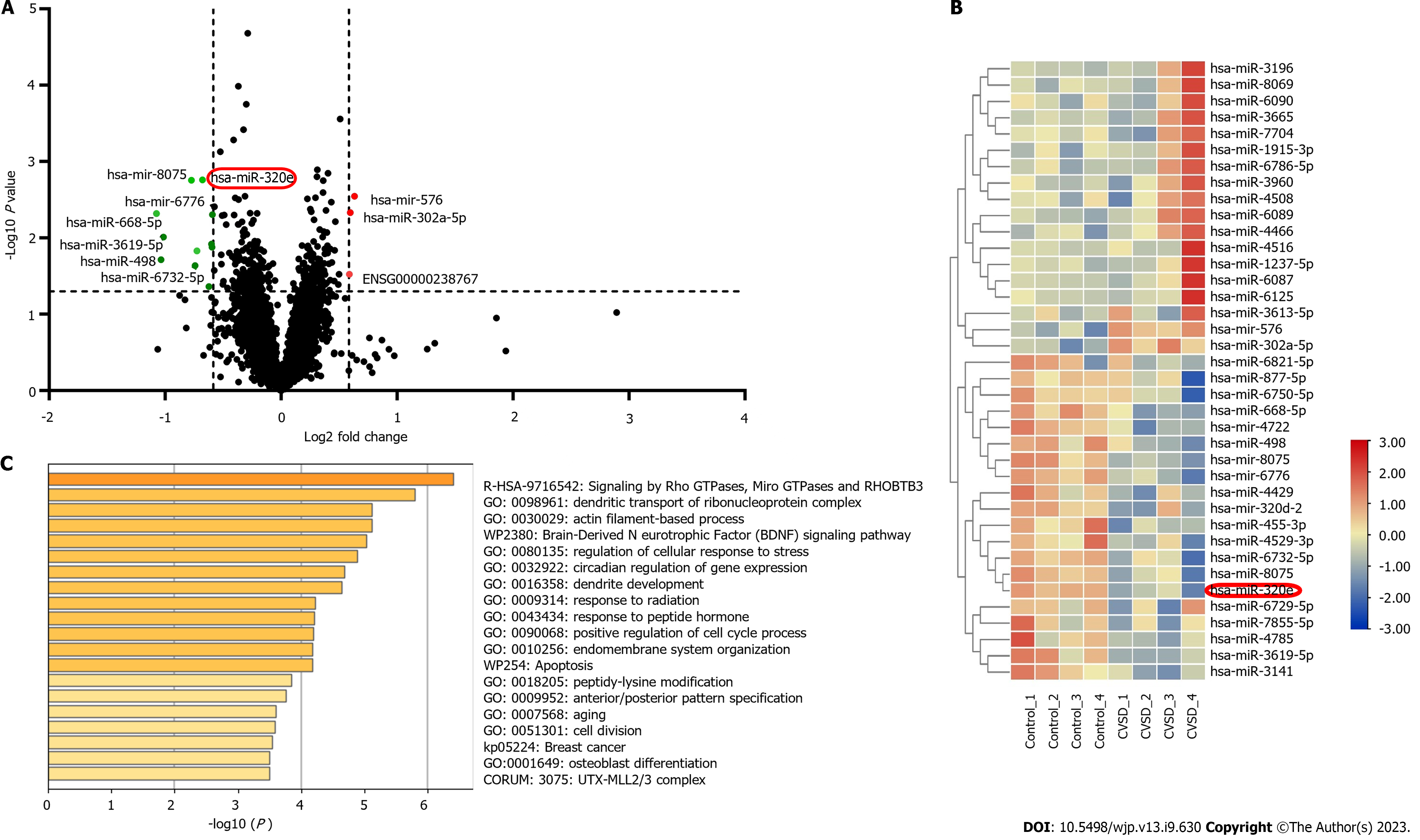Copyright
©The Author(s) 2023.
World J Psychiatry. Sep 19, 2023; 13(9): 630-644
Published online Sep 19, 2023. doi: 10.5498/wjp.v13.i9.630
Published online Sep 19, 2023. doi: 10.5498/wjp.v13.i9.630
Figure 1 Construction and bioinformatics analysis of differentially expressed miRNA libraries.
A: Volcano diagram showing that miRNA-320e was significantly downregulated; B: High-throughput sequencing of plasma exosomes showed that the expression of miR-320e was significantly downregulated; C: Bioinformatics suggested the biological processes involved in differentially expressed miRNAs. Further information was shown in the Supplementary Material.
Figure 2 miR-320e could bind to Wnt2 to inhibit the Wnt/β-catenin pathway.
A: The results of the dual-luciferase reporter gene experiment; B: Binding sequence between Wnt2 mRNA and miR-320e; C and D: Protein blots were listed in the column. After cotransfection of the miR-320e mimic, western blotting showed that Wnt2, FZD2, Axin2, GSK3β, and β-catenin expression increased compared with that of the control group. After cotransfection of the miR-320e inhibitor, western blotting showed that Wnt2, FZD2, Axin2, GSK3β, and β-catenin expression decreased compared with that of the control group; E: Cell image after cotransfection of cells. The image above showed transfection with miR-320e mimic and the one below showed transfection with miR-320e inhibitor. aP < 0.05, bP < 0.01, cP < 0.001.
Figure 3 Representative protein blots of Wnt2, FZD2, Axin2, GSK3β, and β-catenin expression under hydrogen peroxide.
A and B: The Western-Blot results showed that Wnt2 expression in the hydrogen peroxide group increased compared to that in the control group; C: The PCR results showed that Wnt2 expression in the hydrogen peroxide group increased compared to that in the control group; D-F: Expression of Wnt2, FZD2, Axin2, GSK3β, and β-catenin expression after treating with WIF1 and R-Spondin under hydrogen peroxide were similar and further enhanced, respectively, compared to that in the groups without hydrogen peroxide; G and H: The PCR results showed that GSK3β in the WIF + H2O2 group increased, and the other mRNA expression levels remained similar. PCR: Polymerase chain reaction. aP < 0.05, bP < 0.01, cP < 0.001.
Figure 4 miR-320e inhibited the Wnt/β-catenin pathway through targeting Wnt2.
A and B: Cell transfection images were shown; C-E: The Western-Blot results showed that the expression of Wnt2, FZD2, Axin2, GSK3β, and β-catenin in the miR-320e mimics group was inhibited compared to that in the control group, while this inhibition was effectively blocked by Wnt2 silencing compared to the siRNA control; F and G: The results of real-time PCR showed similar trends to the protein levels of Wnt2, FZD2, Axin2, GSK3β, and β-catenin with overexpressed miR-320e and knockdown of Wnt2. PCR: Polymerase chain reaction. aP < 0.05.
Figure 5 The expression of miR-320e in the exosomes secreted by the miR-320e mimic-transfected cells was significantly higher than that in the mimic NC group and the blank control.
A: HUVECs were transfected using miR-320e mimics and the expression of miR-320e was detected. B: Lipid membrane of HUVECs marked by DiI; C: Microplate reader analysis showed that exosomes were also marked by DiI; D: As shown by using marked exosomes harvested from HUVECs and cocultured with HASMCs, HUVECs also showed red fluorescence; E-G: Western blotting and PCR showed that Wnt2 and β-catenin expression in the Exo-mimic group decreased compared to that of the control group. HUVECs: Human umbilical vein endothelial cells; HASMCs: Human aortic vascular smooth muscle cells; PCR: Polymerase chain reaction. aP < 0.05, bP < 0.01.
- Citation: Wang Z, Li XN, Yang SN, Wang Y, Gao KJ, Han B, Ma AJ. Exosomal miR-320e through wnt2targeted inhibition of the Wnt/β-catenin pathway allevisate cerebral small vessel disease and cognitive impairment. World J Psychiatry 2023; 13(9): 630-644
- URL: https://www.wjgnet.com/2220-3206/full/v13/i9/630.htm
- DOI: https://dx.doi.org/10.5498/wjp.v13.i9.630

















